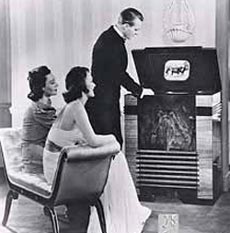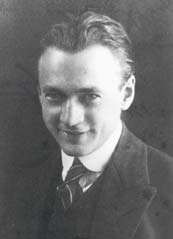Television: Difference between revisions
No edit summary |
No edit summary |
||
| Line 1: | Line 1: | ||
== Television == | == Television == | ||
[[Image:Television1.jpg|thumb|left|When it first came on the scene, television was quite an event. Courtesy: David Sarnoff Library, Princeton, New Jersey.]] | <p>[[Image:Television1.jpg|thumb|left|When it first came on the scene, television was quite an event. Courtesy: David Sarnoff Library, Princeton, New Jersey.]] </p> | ||
In the late 19th century people began thinking about ways to transmit moving pictures. The first systems were mechanical. German Paul Nipkow received the first patent for a TV-like machine in 1884. His system used a large spinning, scanning disk that broke a picture into pieces and then reassembled it on a picture “receiver.” Scotsman [[John Logie Baird|John Logie Baird]] began experimenting with Nipkow discs and created a better mechanical system. He even invented the first video recording system. Baird had some success in the 1920s, but by the mid-1930s everyone, including Baird, knew mechanical television could not compete with the emerging electronic television systems. | <p>In the late 19th century people began thinking about ways to transmit moving pictures. The first systems were mechanical. German Paul Nipkow received the first patent for a TV-like machine in 1884. His system used a large spinning, [[Nipkow Scanning Disk|scanning disk]] that broke a picture into pieces and then reassembled it on a picture “receiver.” Scotsman [[John Logie Baird|John Logie Baird]] began experimenting with Nipkow discs and created a better mechanical system. He even invented the first video recording system. Baird had some success in the 1920s, but by the mid-1930s everyone, including Baird, knew mechanical television could not compete with the emerging electronic television systems. </p> | ||
[[Image:Television2.jpg|thumb|right]] | <p>[[Image:Television2.jpg|thumb|right]] </p> | ||
Electronic television works by making moving pictures out of a fast stream of still pictures, each one slightly different than the picture before it. A TV camera breaks a picture into tiny pieces and sends those pieces to a transmitter. The transmitter transmits (sends) the picture pieces to a receiver. The television receiver in your home gets these signals. The signals control an electron gun, which shoots out electrons. The electrons hit the picture tube, which is coated with phosphors. Phosphors glow when they are hit with electrons. The electron gun sweeps across the screen hitting the phosphor pixels row after row with electrons. This happens so fast that it looks like you’re watching one continuous picture. | <p>Electronic television works by making moving pictures out of a fast stream of still pictures, each one slightly different than the picture before it. A TV camera breaks a picture into tiny pieces and sends those pieces to a transmitter. The transmitter transmits (sends) the picture pieces to a receiver. The television receiver in your home gets these signals. The signals control an electron gun, which shoots out electrons. The electrons hit the picture tube, which is coated with phosphors. Phosphors glow when they are hit with electrons. The electron gun sweeps across the screen hitting the phosphor pixels row after row with electrons. This happens so fast that it looks like you’re watching one continuous picture. </p> | ||
That all sounds pretty simple, but actually making it happen was a lot of hard work by a lot of different people. Inventors such as [[Philo T. Farnsworth|Philo T. Farnsworth]] and Vladimir Zworykin and businessmen such as David Sarnoff invested countless hours and large sums of money into developing good camera tubes and good picture tubes. By 1936 RCA created the National Broadcasting Corporation (NBC), the first American TV network. NBC held its first broadcast at the 1939 World’s Fair and the public was intrigued. World War II put a temporary damper on television development, but by the early 1950s television and its programming, such as sports, game shows, and dramas, had taken hold of the public’s attention and forever changed the way people obtained information. | <p>That all sounds pretty simple, but actually making it happen was a lot of hard work by a lot of different people. Inventors such as [[Philo T. Farnsworth|Philo T. Farnsworth]] and [[Vladimir Zworykin|Vladimir Zworykin]] and businessmen such as [[David Sarnoff|David Sarnoff]] invested countless hours and large sums of money into developing good camera tubes and good picture tubes. By 1936 [[RCA (Radio Corporation of America)|RCA]] created the National Broadcasting Corporation (NBC), the first American TV network. NBC held its first broadcast at the 1939 World’s Fair and the public was intrigued. World War II put a temporary damper on television development, but by the early 1950s television and its programming, such as sports, game shows, and dramas, had taken hold of the public’s attention and forever changed the way people obtained information. </p> | ||
[[Image:Television3.jpg|thumb|left|A young Vladimir Zworykin turns a bright eye towards the future.]] | <p>[[Image:Television3.jpg|thumb|left|A young Vladimir Zworykin turns a bright eye towards the future.]] </p> | ||
Electronic systems got better and better, especially when color TV came on the scene. Although developed in the 1950s, color TV didn’t become common until the late 1960s in the United States, but the basic design stayed pretty much the same until the late 1990s. In that decade high definition TV (HDTV) was introduced. HDTV broadcasts were possible in the 1980s. After years of debate several companies interested in HDTV agreed on technical standards in 1993. The first experimental broadcast was in 1994, but by that time new forms of television were being discussed, such as all-digital TV delivered over the Internet. In 2009, the United States will disontinue all traditional analog television broadcasting, in favor of an all-digital HDTV standard.< | <p>Electronic systems got better and better, especially when color TV came on the scene. Although developed in the 1950s, color TV didn’t become common until the late 1960s in the United States, but the basic design stayed pretty much the same until the late 1990s. In that decade high definition TV (HDTV) was introduced. HDTV broadcasts were possible in the 1980s. After years of debate several companies interested in HDTV agreed on technical standards in 1993. The first experimental broadcast was in 1994, but by that time new forms of television were being discussed, such as all-digital TV delivered over the Internet. In 2009, the United States will disontinue all traditional analog television broadcasting, in favor of an all-digital HDTV standard.</p> | ||
< | <p>[[Category:Communications]] [[Category:TV]] [[Category:Components,_circuits,_devices_&_systems|Category:Components,_circuits,_devices_&_systems]] [[Category:Electron_devices]] [[Category:Electron_guns]] [[Category:Communication_equipment]] [[Category:Transmitters]] [[Category:News]]</p> | ||
[[Category:Communications]] [[Category:TV]] [[Category:Components,_circuits,_devices_&_systems|Category:Components,_circuits,_devices_&_systems]] [[Category:Electron_devices]] [[Category:Electron_guns]] [[Category:Communication_equipment]] [[Category:Transmitters]][[Category:News]] | |||
Revision as of 19:18, 19 May 2010
Television
In the late 19th century people began thinking about ways to transmit moving pictures. The first systems were mechanical. German Paul Nipkow received the first patent for a TV-like machine in 1884. His system used a large spinning, scanning disk that broke a picture into pieces and then reassembled it on a picture “receiver.” Scotsman John Logie Baird began experimenting with Nipkow discs and created a better mechanical system. He even invented the first video recording system. Baird had some success in the 1920s, but by the mid-1930s everyone, including Baird, knew mechanical television could not compete with the emerging electronic television systems.
Electronic television works by making moving pictures out of a fast stream of still pictures, each one slightly different than the picture before it. A TV camera breaks a picture into tiny pieces and sends those pieces to a transmitter. The transmitter transmits (sends) the picture pieces to a receiver. The television receiver in your home gets these signals. The signals control an electron gun, which shoots out electrons. The electrons hit the picture tube, which is coated with phosphors. Phosphors glow when they are hit with electrons. The electron gun sweeps across the screen hitting the phosphor pixels row after row with electrons. This happens so fast that it looks like you’re watching one continuous picture.
That all sounds pretty simple, but actually making it happen was a lot of hard work by a lot of different people. Inventors such as Philo T. Farnsworth and Vladimir Zworykin and businessmen such as David Sarnoff invested countless hours and large sums of money into developing good camera tubes and good picture tubes. By 1936 RCA created the National Broadcasting Corporation (NBC), the first American TV network. NBC held its first broadcast at the 1939 World’s Fair and the public was intrigued. World War II put a temporary damper on television development, but by the early 1950s television and its programming, such as sports, game shows, and dramas, had taken hold of the public’s attention and forever changed the way people obtained information.
Electronic systems got better and better, especially when color TV came on the scene. Although developed in the 1950s, color TV didn’t become common until the late 1960s in the United States, but the basic design stayed pretty much the same until the late 1990s. In that decade high definition TV (HDTV) was introduced. HDTV broadcasts were possible in the 1980s. After years of debate several companies interested in HDTV agreed on technical standards in 1993. The first experimental broadcast was in 1994, but by that time new forms of television were being discussed, such as all-digital TV delivered over the Internet. In 2009, the United States will disontinue all traditional analog television broadcasting, in favor of an all-digital HDTV standard.

